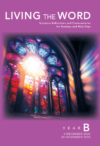Scripture Study for
Fourth Sunday of Advent
Isaiah 7:10–14 / Psalm 24:7c and 10b / Romans 1:1–7 / Matthew 1:18–24
<< Back to LECTIONARY RESOURCES
Understanding the Word
By Br. John R. Barker, OFM
Isaiah understood that the “house of David” was protected by God, according to God’s promise to David (2 Samuel 7:11–16). King Ahaz, threatened by surrounding states seeking to depose him, contemplates turning to the Assyrian Empire for help, an act reflecting a lack of faith in God’s protection. Not wishing not be dissuaded from his political course, the king “piously” declines God’s offer of a sign of his continued support of the Davidic monarchy. Nevertheless, the prophet points to a sign, which is a “young woman” (in Hebrew; “virgin” in the Greek translation) who is pregnant (future tense in the Greek). The son to be born will inherit the throne of David, making him a sign of fidelity to God’s promise.
Paul begins his letter to the Romans by setting out the core of his message about Christ Jesus, which is the good news, earlier announced in Israel’s scriptures, that God has sent a descendant of David and confirmed him as Messiah and Lord by raising him from the dead. Paul himself is a “slave” of Christ—not degraded chattel but an apostle of the gospel to the Gentiles, a role he has been given by God that they too may belong to Christ through the “obedience of faith.” This phrase refers to the summons to acknowledge Jesus’ lordship and so enter into covenant relationship with God by “belonging to Christ.”
The Matthean annunciation focuses on Joseph, a “son of David.” The child to born will come from the house of David, as most expected the Messiah would. An adopted child was as much a child of the adoptive parents as any biological child. So, Joseph, the adoptive father, could be considered the “real” (human) father of Jesus. Jesus’ descent from David is not “apparent” but, according to Jewish cultural norms, actual. Two names point toward his identity. Jesus (in Aramaic Yeshua) means “He will save,” while “Emmanuel” indicates that he will be both the sign and the reality of God’s presence to Israel.
